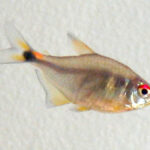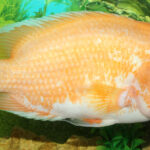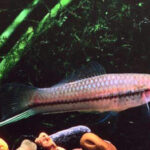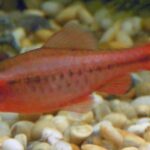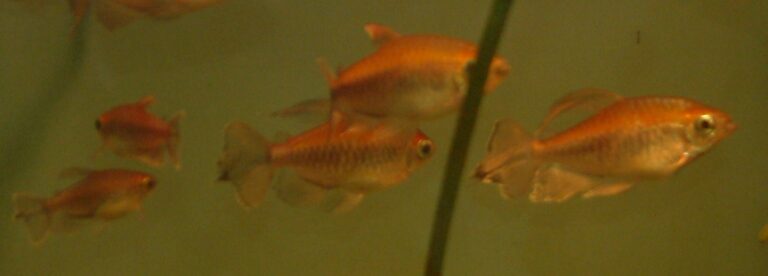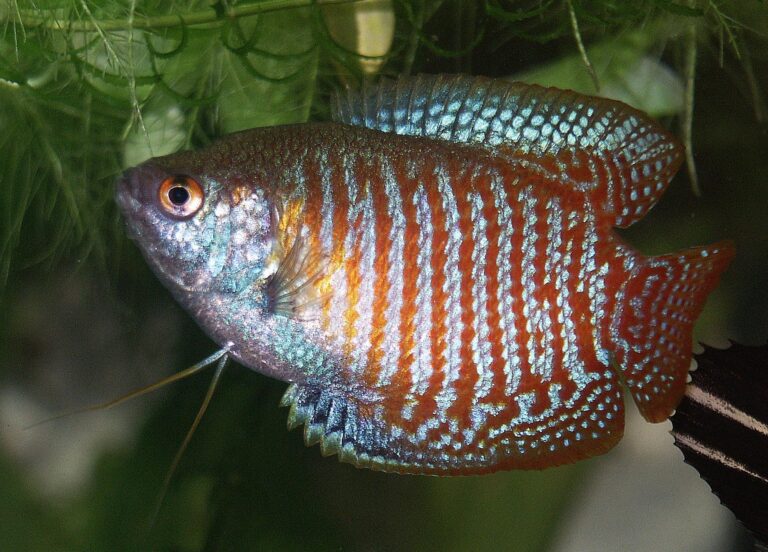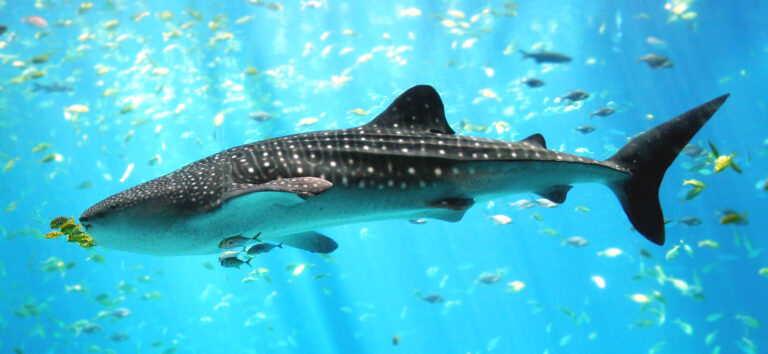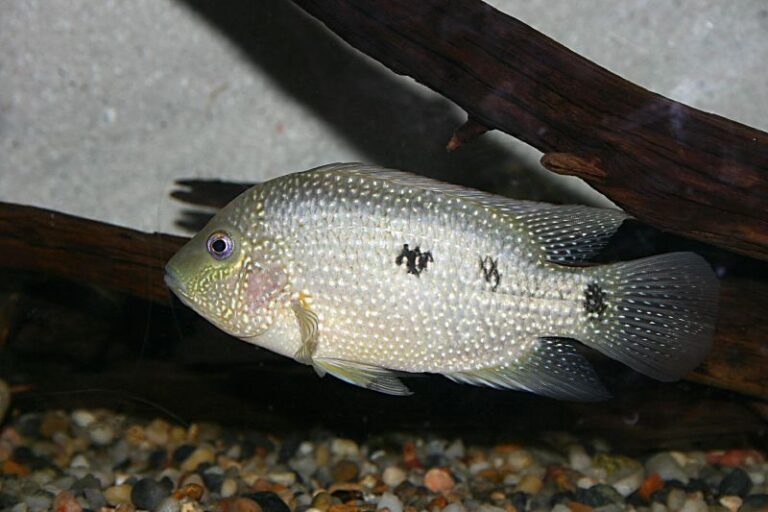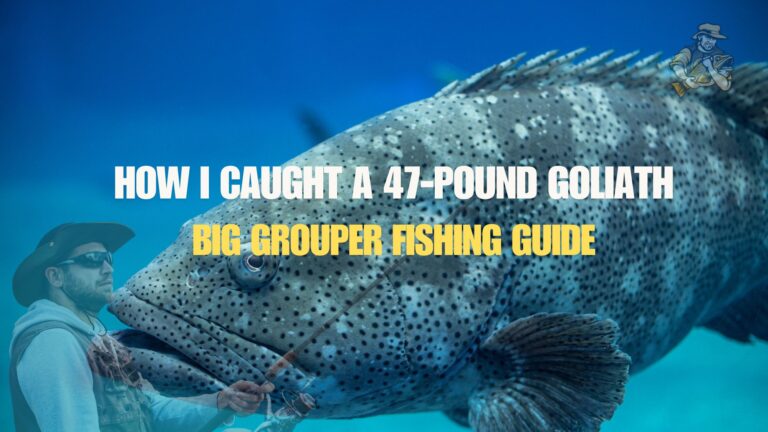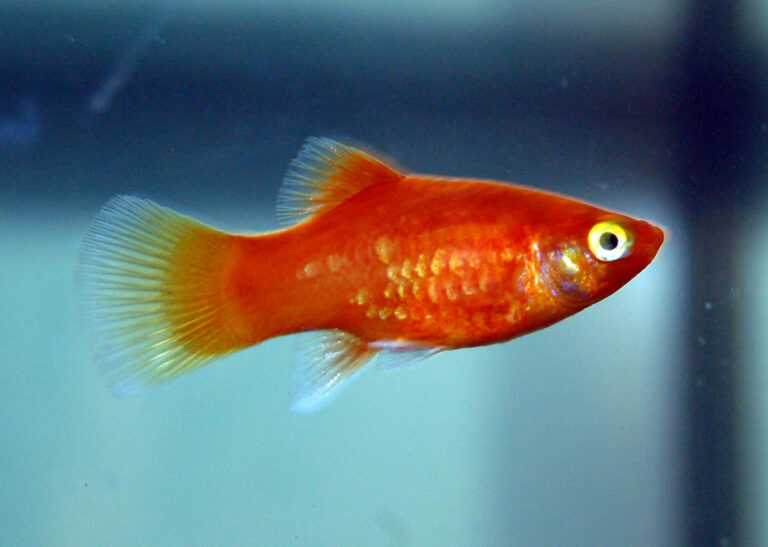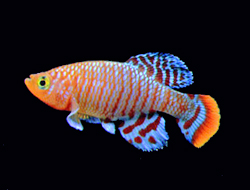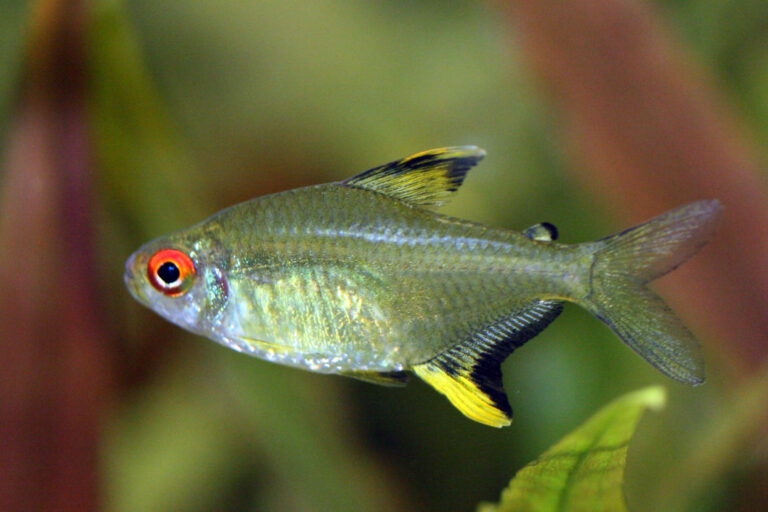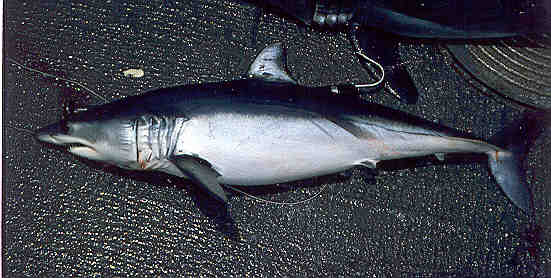Gold Gourami
By Ryan Maron | Last Modified: June 10, 2025

The Gold Gourami (Trichopodus trichopterus) represents one of Southeast Asia’s most recognizable freshwater fish species, distinguished by its robust constitution and distinctive golden coloration. Originally native to the river systems and wetlands of Thailand, Malaysia, Vietnam, and Myanmar, this labyrinth fish has become established in aquatic ecosystems worldwide through both intentional introductions and aquarium releases. The species serves as an important component of its native freshwater communities, functioning as both predator and prey while contributing to the complex food webs of tropical Asian waterways.
As a member of the gourami family, the Gold Gourami demonstrates remarkable physiological adaptations that allow it to thrive in oxygen-poor environments. Its specialized labyrinth organ enables atmospheric breathing, providing significant ecological advantages in stagnant waters and shallow marshlands where dissolved oxygen levels fluctuate dramatically. This adaptation has made the species particularly successful in colonizing diverse aquatic habitats beyond its natural range, establishing sustainable populations in regions spanning from North America to Australia.
| Feature | Details |
| Common Name | Gold Gourami |
| Scientific Name | Trichopodus trichopterus |
| Family | Osphronemidae |
| Typical Size | 10-15 cm (4-6 inches), 80-120 grams |
| Habitat | Slow-moving freshwater systems |
| Diet | Omnivorous opportunist |
| Distribution | Southeast Asia, introduced globally |
| Conservation Status | Least Concern |
Taxonomy & Classification
The Gold Gourami belongs to the family Osphronemidae, commonly known as the gourami family, which encompasses approximately 130 species of labyrinth fish distributed across Africa and Asia. Within this family, Trichopodus trichopterus holds particular significance as the type species for its genus, originally described by German naturalist Peter Simon Pallas in 1770. The species exhibits considerable morphological variation across its range, leading to the recognition of several color variants including the golden, blue, and opaline forms.
Genetic analysis has revealed that the Gold Gourami represents a selectively bred color morph rather than a distinct subspecies, derived from the wild-type Three-spot Gourami through aquaculture practices in Southeast Asia. The golden coloration results from reduced melanophore activity combined with enhanced xanthophore and erythrophore expression, producing the characteristic yellow-gold hue that distinguishes this variant from its wild counterparts.
Recent phylogenetic studies place Trichopodus within the subfamily Osphroneminae, closely related to the genera Colisa and Sphaerichthys. The evolutionary relationships within this group suggest a complex history of adaptive radiation throughout Southeast Asian river systems, with specialized adaptations for varying environmental conditions driving speciation events over the past 15 million years.
Physical Description
The Gold Gourami displays a laterally compressed, oval-shaped body profile characteristic of the gourami family, with adult specimens typically reaching lengths of 10-15 centimeters. The species exhibits pronounced sexual dimorphism, with males developing elongated dorsal and anal fins that extend toward the caudal peduncle, while females maintain shorter, more rounded fin profiles. The distinctive golden coloration varies in intensity from pale yellow to deep amber, often displaying subtle iridescent qualities under optimal lighting conditions.
The most recognizable feature of the Gold Gourami involves its modified pelvic fins, which have evolved into thread-like sensory organs containing numerous taste buds and mechanoreceptors. These specialized appendages, extending well beyond the fish’s body length, serve crucial functions in navigation, prey detection, and social communication within turbid water environments. The labyrinth organ, located in the gill chamber, appears as a highly vascularized structure enabling atmospheric oxygen uptake through specialized respiratory tissue.
Adult males develop notable morphological changes during breeding condition, including enhanced coloration intensity and the formation of temporary tubercles along the head and opercular regions. The dorsal fin typically contains 6-8 soft rays, while the anal fin displays 8-10 rays with distinctive elongation in mature males. Body scales number approximately 28-32 along the lateral line, with each scale displaying characteristic golden iridescence that intensifies under stress or excitement.
Habitat & Distribution
The native range of the Gold Gourami encompasses the freshwater systems of Southeast Asia, including the Mekong River basin, Chao Phraya River system, and numerous smaller waterways throughout Thailand, Vietnam, Cambodia, and southern Myanmar. Within these regions, the species demonstrates remarkable habitat flexibility, occupying slow-moving rivers, stagnant pools, rice paddies, and seasonal wetlands characterized by dense aquatic vegetation and fluctuating water levels.
Optimal habitat conditions for Gold Gourami populations include water temperatures ranging from 22-28°C, pH levels between 6.0-8.0, and dissolved oxygen concentrations as low as 2-3 mg/L due to their atmospheric breathing capabilities. The species shows strong preference for areas with abundant surface vegetation, utilizing floating plants for nest construction and juvenile protection while exploiting the complex three-dimensional habitat structure these environments provide.
Human-mediated introductions have established Gold Gourami populations across multiple continents, with documented breeding colonies in the southern United States, northern Australia, parts of South America, and various Caribbean islands. These introduced populations often concentrate in warm-water discharge areas, irrigation canals, and shallow lakes where temperature regimes approximate their native tropical conditions. The species’ remarkable adaptability has enabled successful colonization of modified aquatic habitats, including urban retention ponds and agricultural waterways.
Diet & Feeding Behavior
Gold Gourami exhibits opportunistic omnivorous feeding behavior, consuming diverse prey items that reflect seasonal and habitat-specific resource availability. Primary dietary components include small invertebrates such as mosquito larvae, chironomid midges, copepods, and various aquatic insects, supplemented by plant matter including algae, decomposing vegetation, and occasionally small seeds or fruits that fall into the water column.
Feeding strategies vary considerably based on environmental conditions and prey density. During daylight hours, Gold Gourami typically employ visual hunting techniques, using their enlarged eyes to detect movement among aquatic vegetation. The specialized thread-like pelvic fins serve as tactile sensors, allowing detection of hidden prey items within substrate crevices or dense plant growth where visual cues prove insufficient.
The species demonstrates notable behavioral plasticity in feeding approaches, shifting between surface feeding on terrestrial insects, mid-water predation on zooplankton, and benthic foraging for invertebrate larvae. Juvenile Gold Gourami focus primarily on microscopic prey including rotifers, small cladocerans, and newly hatched insect larvae, while adults incorporate larger prey items and significant plant material into their dietary repertoire. This feeding flexibility contributes substantially to their ecological success across diverse aquatic environments.
Behavior & Adaptations
The Gold Gourami displays complex behavioral patterns that reflect both individual survival strategies and social interactions within their aquatic communities. Adult specimens typically exhibit semi-territorial behavior, establishing loosely defined home ranges around productive feeding areas or suitable breeding sites. However, territorial aggression remains relatively subdued compared to other gourami species, with confrontations usually limited to ritualized displays rather than physical combat.
The species’ most remarkable adaptation involves the specialized labyrinth organ, which functions as an accessory respiratory system enabling survival in oxygen-depleted waters. This physiological innovation allows Gold Gourami to exploit ecological niches unavailable to conventional gill-breathing fish, particularly in stagnant waters, shallow wetlands, and areas with high organic decomposition rates that severely reduce dissolved oxygen levels.
Social behavior varies significantly with environmental conditions and population density. In resource-rich environments, Gold Gourami may form loose aggregations around feeding sites, displaying minimal aggression toward conspecifics. However, during breeding season or in confined spaces, individuals become increasingly territorial, with males establishing and defending specific areas suitable for bubble nest construction. The thread-like pelvic fins serve important roles in social communication, with tactile contact between individuals conveying information about size, reproductive status, and aggressive intent.
Reproduction & Life Cycle
Gold Gourami reproduction follows the characteristic bubble-nesting strategy employed by most members of the Osphronemidae family. Breeding typically occurs during warmer months when water temperatures exceed 26°C and seasonal rains provide optimal conditions for fry survival. Males initiate reproductive behavior by constructing elaborate bubble nests at the water surface, incorporating plant debris and secreted mucus to create floating platforms measuring 5-10 centimeters in diameter.
The courtship process involves complex behavioral displays, with males developing intensified coloration and performing elaborate swimming patterns to attract females. Successful courtship culminates in a characteristic spawning embrace beneath the bubble nest, during which the female releases 100-800 eggs that the male immediately fertilizes and collects in his mouth before depositing them within the nest structure.
Parental care responsibilities fall exclusively to the male, who guards the nest territory aggressively while maintaining optimal egg conditions through constant bubble replenishment and removal of fungal infections. Eggs typically hatch within 24-36 hours at temperatures of 27-29°C, with newly emerged fry remaining attached to the nest via oil globules for an additional 2-3 days. Male parental care continues until fry achieve free-swimming status, approximately 5-7 days post-hatching, after which parental bonds dissolve and juveniles disperse into surrounding vegetation. Sexual maturity occurs at 6-8 months of age, corresponding to body lengths of approximately 6-8 centimeters.
Predators & Threats
Within their native ecosystems, Gold Gourami face predation pressure from various aquatic and semi-aquatic species throughout different life stages. Adult specimens encounter predation from larger fish species including snakeheads (Channidae), large catfish, and predatory cyprinids, while eggs and fry remain vulnerable to smaller fish, aquatic invertebrates, and amphibian larvae. Avian predators such as herons, kingfishers, and other piscivorous birds pose significant threats in shallow water environments where Gold Gourami frequently feed and breed.
Environmental threats to Gold Gourami populations include habitat degradation through agricultural development, water pollution from industrial and domestic sources, and climate change impacts affecting seasonal precipitation patterns. Intensive rice cultivation practices often involve pesticide applications that directly impact gourami populations, while urbanization leads to wetland drainage and modification of natural water flow patterns essential for successful reproduction.
In introduced populations, Gold Gourami face different threat profiles including predation from native species adapted to exploit similar ecological niches. Cold temperature events represent major limiting factors for established populations in temperate regions, with winter temperatures below 15°C typically causing significant mortality. However, the species’ remarkable adaptability and reproductive potential often enable rapid population recovery following environmental disturbances, contributing to their persistence across diverse geographic regions.
Conservation Status
The International Union for Conservation of Nature (IUCN) classifies the Gold Gourami as Least Concern, reflecting the species’ stable population status throughout most of its native range and successful establishment in numerous introduced locations. Large, reproductively viable populations persist across Southeast Asia despite ongoing habitat modifications and environmental pressures associated with human development activities.
However, localized population declines have been documented in heavily industrialized river systems and areas subjected to intensive agricultural practices. The Mekong River basin, which supports some of the largest native Gold Gourami populations, faces increasing pressure from dam construction, pollution inputs, and climate change impacts that may affect long-term population stability. Monitoring programs initiated by regional fisheries management agencies have begun tracking population trends in key watersheds to identify potential conservation concerns before they become critical.
The species’ widespread introduction beyond its native range presents complex conservation implications, as established populations may impact native fish communities through competition and predation. Several jurisdictions have implemented regulations restricting Gold Gourami importation and release, while management programs focus on controlling established populations in sensitive ecosystems. Despite these localized concerns, the overall conservation outlook for Gold Gourami remains positive due to their adaptability and broad geographic distribution.
Human Interaction
Gold Gourami holds significant cultural and economic importance throughout Southeast Asia, where the species serves as both a traditional food source and popular aquarium fish. In rural communities across Thailand, Vietnam, and Cambodia, Gold Gourami represents an important protein source harvested from rice paddies, irrigation canals, and natural wetlands through traditional fishing methods including bamboo traps, cast nets, and simple hook-and-line techniques.
The global aquarium trade has transformed Gold Gourami into one of the most widely recognized ornamental fish species, with commercial breeding operations producing millions of specimens annually for international distribution. Selective breeding programs have developed numerous color variants and fin modifications, creating distinct aquarium strains that differ substantially from wild-type populations. This commercial success has contributed to the species’ inadvertent introduction into non-native watersheds through aquarium releases and breeding facility escapes.
Recreational fishing opportunities involving Gold Gourami remain limited in most regions due to their relatively small size and specialized habitat requirements. However, in areas with established introduced populations, the species occasionally provides targets for specialized light-tackle fishing approaches, particularly in warm-water discharge areas and shallow lake systems. Basic fishing techniques prove most effective for Gold Gourami, using small hooks, light line, and natural baits such as worms or small insects to match their feeding preferences.
Interesting Facts
The Gold Gourami possesses several remarkable physiological and behavioral characteristics that distinguish it from most freshwater fish species. Their labyrinth organ functions so efficiently that individuals can survive for extended periods in water with virtually no dissolved oxygen, provided they maintain access to the surface for atmospheric breathing. This adaptation has enabled survival in temporary pools that would prove lethal to conventional fish species, contributing significantly to their ecological success.
Male Gold Gourami demonstrate exceptional parental dedication during the breeding season, with some individuals maintaining continuous nest attendance for up to two weeks while rarely leaving to feed. The bubble nests they construct can contain over 10,000 individual bubbles, each coated with specialized mucus that provides both structural integrity and antimicrobial properties to protect developing eggs from fungal infections.
The species exhibits remarkable longevity for a small freshwater fish, with documented lifespans exceeding eight years in optimal conditions. Wild populations show evidence of seasonal migrations between deep winter refugia and shallow breeding areas, covering distances up to several kilometers despite their generally sedentary nature. Gold Gourami can survive in water temperatures as low as 10°C for brief periods, though extended exposure below 15°C typically proves fatal to most individuals.
Their thread-like pelvic fins contain over 200 individual taste buds, providing sensory acuity comparable to some catfish species. This adaptation proves particularly valuable in turbid water conditions where visual prey detection becomes difficult, allowing continued feeding success in challenging environmental conditions.
Frequently Asked Questions
Can Gold Gourami survive in outdoor ponds year-round?
Gold Gourami can survive in outdoor ponds only in regions where water temperatures remain above 15°C throughout the winter months. In temperate climates, they require heated indoor accommodation during cold seasons, as prolonged exposure to temperatures below 10°C typically proves fatal. Their tropical origins make them unsuitable for permanent outdoor culture in most North American and European locations.
How do Gold Gourami compare to other aquarium fish in terms of care requirements?
Gold Gourami rank among the hardier aquarium species due to their labyrinth organ adaptation, which provides tolerance for varying water quality conditions. Unlike more sensitive species such as various betta fish types, Gold Gourami can withstand temporary oxygen depletion and moderate pH fluctuations. However, they require larger tanks than many popular aquarium fish and may show aggression toward smaller tank mates.
What role do Gold Gourami play in controlling mosquito populations?
Gold Gourami provide valuable biological control of mosquito larvae in their native and introduced habitats, consuming significant quantities of these pest insects during their aquatic development stages. A single adult Gold Gourami can consume dozens of mosquito larvae daily, making them beneficial in rice paddies and other standing water environments where mosquito reproduction occurs. This ecological service has led to intentional introductions in some regions for pest control purposes.
Are Gold Gourami considered invasive species in introduced locations?
Gold Gourami classifications vary by jurisdiction, with some regions listing them as prohibited invasive species while others permit their presence. In Florida and parts of Australia, established populations have raised concerns about impacts on native fish communities, leading to management programs aimed at population control. However, in many introduced locations, they appear to coexist with native species without causing significant ecological disruption, particularly in modified habitats where native fish diversity was already reduced.
Conclusion
The Gold Gourami stands as a testament to evolutionary adaptability and ecological resilience, successfully thriving across diverse freshwater environments through specialized physiological innovations and flexible behavioral strategies. From their native Southeast Asian watersheds to introduced populations worldwide, these remarkable fish continue to demonstrate the complex relationships between species adaptation, human influence, and ecosystem dynamics. Their dual role as both valued aquarium specimens and important components of freshwater communities ensures continued scientific and cultural significance for generations to come.
Share The Article:
More Fish Species:
-
Congo Tetra
The Congo Tetra stands as one of Africa’s most remarkable freshwater fish species, captivating aquarists and ichthyologists alike with…
-
Dalmatian Molly
The Dalmatian Molly stands as one of the most recognizable and beloved freshwater aquarium fish, distinguished by its striking…
-
Dwarf Gourami
The Dwarf Gourami (Trichogaster lalius) stands as one of the most popular freshwater aquarium fish species, renowned for its…
-
Black Neon Tetra
The Black Neon Tetra (Hyphessobrycon herbertaxelrodi) stands as one of the most distinctive freshwater fish species in the aquarium…
-
Whale Shark
The whale shark (*Rhincodon typus*) stands as the ocean’s largest fish species, representing one of nature’s most remarkable gentle…
-
Texas Cichlid
The Texas Cichlid (Herichthys cyanoguttatus) stands as one of North America’s most distinctive freshwater fish species, representing the sole…
Discover
-
Fly Fishing | How to fly fish in 2025?
Fly fishing has changed a lot since I first picked up a rod back in the mid-90s. The fundamentals…
-
Great Lakes Fishing Tactics That Nobody Talks About (But Should)
Ever notice how some anglers consistently haul in impressive catches from the Great Lakes while others struggle to get…
-
Pennsylvania Fishing License: Complete Guide for Anglers in 2025
Getting your Pennsylvania fishing license sorted isn’t exactly the most exciting part of fishing, but it’s absolutely necessary if…
-
How to Spool a Baitcaster for Beginners: 6 Simple Steps
I remember the first time I tried spooling a baitcaster reel. What should have been a simple 15-minute job…
-
Ice Fishing Techniques for Anglers in 2025
Last January, I was out on Higgins Lake during that brutal cold snap – you remember, when it dropped…
-
Great White Shark
The Great White Shark (*Carcharodon carcharias*) stands as one of the ocean’s most formidable apex predators, commanding respect and…
Discover
-
How I Caught a 47-Pound Goliath: Big Grouper Fishing Guide
That morning started like most fishing trips – with complete optimism followed by immediate disappointment. We’d motored 12 miles…
-
Coral Platy
The Coral Platy (Xiphophorus maculatus) represents one of the most recognizable and beloved freshwater aquarium fish in the world….
-
Killifish
Killifish represent one of the most diverse and ecologically significant groups of small freshwater and brackish water fish, comprising…
-
Lemon Tetra
The Lemon Tetra (*Hyphessobrycon pulchripinnis*) stands as one of South America’s most vibrant freshwater fish species, distinguished by its…
-
East Coast Surf Fishing: Targeting Striped Bass and Bluefish from Shore
When I first tried East Coast surf fishing nearly 15 years ago, I was absolutely terrible at it. I…
-
Shortfin Mako Shark
The Shortfin Mako Shark stands as one of the ocean’s most remarkable predators, combining exceptional speed with sophisticated hunting…

